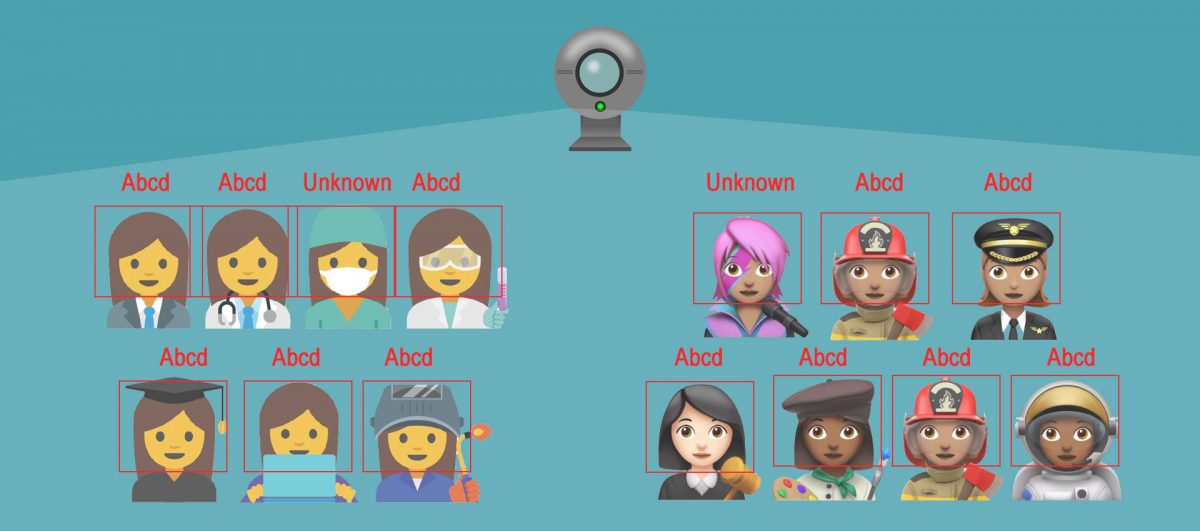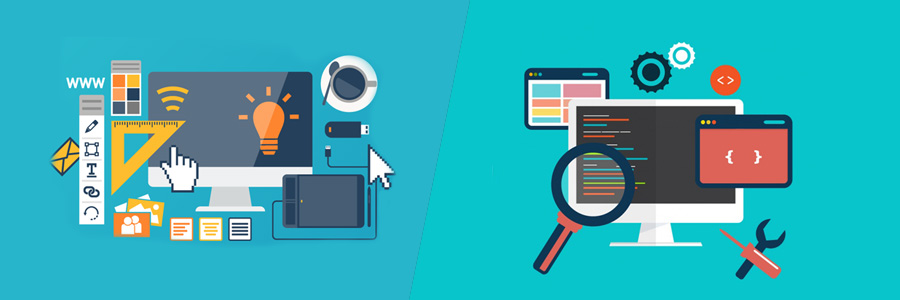Author: TRIUMINFO
Facebook likely to launch ‘Portal’ video chat device using AI
Facebook is reportedly set to announce its own video chat device called Portal next week, taking on Amazon’s smart home devices.
Portal will take on Amazon’s Echo Show and will be available in two variants, Cheddar reported on Friday.A larger variant could be priced at around $400, while a smaller variant could go for around $300.
However, it will have integration with Amazon’s Alexa voice assistant and let users play music, watch videos, see cooking recipes, and get news briefs.
Amazon Echo Show and Echo Spot devices add video to the audio experience via voice assistant Alexa. While Echo home devices are microphone-equipped speakers, the Amazon Echo Show and Spot also include a display.
The report said that Facebook had originally planned to announce Portal at its annual F8 developer conference in May “But the company’s scandals, including the Cambridge Analytica data breach and the bombshell revelation that Russia used the platform to interfere with the 2016 elections, led executives to shelve the announcement at the last minute”
The social media giant was yet to comment on this development.
Portal will also reportedly feature a privacy shutter that can cover the device’s wide-angle video camera. It will apparently use Artificial Intelligence (AI) to recognise people in the frame and follow them as they move throughout a room.
How Is AI Used In Healthcare – 5 Powerful Real-World Examples That Show The Latest Advances
When it comes to our health, especially in matters of life and death, the promise of artificial intelligence (AI) to improve outcomes is very intriguing. While there is still much to overcome to achieve AI-dependent health care, most notably data privacy concerns and fears of mismanaged care due to machine error and lack of human oversight, there is sufficient potential that governments, tech companies, and healthcare providers are willing to invest and test out AI-powered tools and solutions. Here are five of the AI advances in healthcare that appear to have the most potential.
1. AI-assisted robotic surgery
With an estimated value of $40 billion to healthcare, robots can analyze data from pre-op medical records to guide a surgeon’s instrument during surgery, which can lead to a 21% reduction in a patient’s hospital stay. Robot-assisted surgery is considered “minimally invasive” so patients won’t need to heal from large incisions. Via artificial intelligence, robots can use data from past operations to inform new surgical techniques. The positive results are indeed promising. One study that involved 379 orthopedic patients found that AI-assisted robotic procedure resulted in five times fewer complications compared to surgeons operating alone. A robot was used on an eye surgery for the first time, and the most advanced surgical robot, the Da Vinci allows doctors to perform complex procedures with greater control than conventional approaches. Heart surgeons are assisted Heartlander, a miniature robot, that enters a small incision on the chest to perform mapping and therapy over the surface of the heart.
2. Virtual nursing assistants
From interacting with patients to directing patients to the most effective care setting, virtual nursing assistants could save the healthcare industry $20 billion annually. Since virtual nurses are available 24/7, they can answer questions, monitor patients and provide quick answers. Most applications of virtual nursing assistants today allow for more regular communication between patients and care providers between office visits to prevent hospital readmission or unnecessary hospital visits. Care Angel’s virtual nurse assistant can even provide wellness checks through voice and AI.
3. Aid clinical judgment or diagnosis
Admittedly, using AI to diagnose patients is undoubtedly in its infancy, but there have been some exciting use cases. A Stanford University study tested an AI algorithm to detect skin cancers against dermatologists, and it performed at the level of the humans. A Danish AI software company tested its deep-learning program by having a computer eavesdrop while human dispatchers took emergency calls. The algorithm analyzed what a person says, the tone of voice and background noise and detected cardiac arrests with a 93% success rate compared to 73% for humans. Baidu Research recently announced that the results of early tests on its deep learning algorithm indicate that it can outperform humans when identifying breast cancer metastasis. Prime minister Theresa May announced an AI revolution would help the National Health Service (NHS), the UK’s healthcare system, predict those in an early stage of cancer to ultimately prevent thousands of cancer-related deaths by 2033. The algorithms will examine medical records, habits and genetic information pooled from health charities, the NHS and AI.
4. Workflow and administrative tasks
Another way AI can impact healthcare is to automate administrative tasks. It is expected that this could result in $18 billion in savings for the healthcare industry as machines can help doctors, nurses and other providers save time on tasks. Technology such as voice-to-text transcriptions could help order tests, prescribe medications and write chart notes. One example of using AI to support admin tasks is a partnership between the Cleveland Clinic and IBM that uses IBM’s Watson to mine big data and help physicians provide a personalized and more efficient treatment experience. One way Watson supports physicians is being able to analyze thousands of medical papers using natural language processing to inform treatment plans.
5. Image analysis
Currently, image analysis is very time consuming for human providers, but an MIT-led research team developed a machine-learning algorithm that can analyze 3D scans up to 1,000 times faster than what is possible today. This near real-time assessment can provide critical input for surgeons who are operating. It is also hoped that AI can help to improve the next generation of radiology tools that don’t rely on tissue samples. Additionally, AI image analysis could support remote areas that don’t have easy access to health care providers and even make telemedicine more effective as patients can use their camera phones to send in pics of rashes, cuts or bruises to determine what care is necessary.
In the very complex world of healthcare, AI tools can support human providers to provide faster service, diagnose issues and analyze data to identify trends or genetic information that would predispose someone to a particular disease. When saving minutes can mean saving lives, AI and machine learning can be transformative not only for healthcare but for every single patient.
Source : https://www.forbes.com/sites/bernardmarr/2018/07/27/how-is-ai-used-in-healthcare-5-powerful-real-world-examples-that-show-the-latest-advances/#1eca000b5dfb
Trium Info – Facial Recognition (Artificial Intelligence & Machine Learning)
This is a demo video of our state-of-the-art facial recognition system. We have achieved an accuracy rate of up to 98%.
It can be used for security and attendance purposes in almost all sectors such as Education and Corporates. This software is available as an API, a standalone desktop app and Web interface which can easily be integrated into your system.
For more info you can post your email in the comment and our team will get back to you ASAP.
Website: https://camersof.com/
Thank You
What is AI and ML
What is Data Science?
Let’s break the term into its composite parts – data and science. Science works fundamentally through the formulation of hypotheses – educated guesses that seek to explain how something works – and then finding enough reasonable evidence through observations in the real world to either prove the hypothesis right, or falsify it. Data, on the other hand, refers simply to numbers and statistics which we gather for the sake of analysis.
By combining these two, we get data science. What exactly does it mean? Data science is an umbrella term for all techniques and methods that we use to analyze massive amounts of data with the purpose of extracting knowledge from them.
Example of Data Science

Source : Acadgild
Let’s say you are crazy about Cricket, which I am sure you areJ, and there is an ongoing series between India and Australia. India loses the first two matches, much to your disappointment, and you are eager to know what will happen in the next game. You go online to check the results of past encounters between the two nations and notice a trend – every time India has lost two games in a row against Australia, they have come back strongly in the third. You are convinced India will win the next game, and predict the outcome. To everyone’s surprise, your prediction turns out right. Congratulations, you’re a data scientist!
The numbers and statistics that a data scientist observes in the real world may not be so simple, and he/she might even require software to recognize the underlying trends. Nonetheless, the basic idea is the same. Due to its efficiency in predicting outcomes, data science is useful in developing artificial intelligence – what we will explore next.
Artificial Intelligence:
Artificial intelligence (AI) is a very broad term. Chiefly, it is an attempt to make computers think like human beings. Any technique, code or algorithm that enables machines to develop, mimic, and demonstrate human cognitive abilities or behaviors falls under this category. An artificial intelligence system can be as simple as a software that plays chess, or more complex like a car without a driver. No matter how complex the system, artificial intelligence is only in its nascent stages. We are in what many call “the era of weak AI”. In the future we might enter the era of strong AI, when computers and machines can replicate anything and everything humans do.
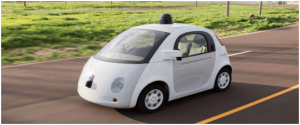
Source : Business Insider
The saying, “be careful what you wish for” is extremely apt when discussing artificial intelligence. The emergence of AI has thrown up new challenges almost as a by-product of the advanced technology. While it’s good that a car which doesn’t need a driver can take you to your destination with little or no effort on your part, it would be terrible if it crashed along the way. Similarly, it’s good that robots can help with work in industries. However, it won’t be so good, if they declared war against humans. I digress. These are discussions for another time, and I want to move on to the topic of machine learning in the next section.
Machine Learning:
Machine learning is one of the hottest technologies right now. It refers to, as the name suggests, a computer’s ability to learn from a set of data, and adapt itself without being programmed to do so. It’s one kind of artificial intelligence that builds algorithms which can analyze input data to predict an output that falls within an acceptable range.
Supervised Learning
Machine learning algorithms can be of different kinds. The most common of these are “supervised algorithms”. These algorithms make observations using “labels”, which are nothing but predictable outcomes.

Source : Acadgild
Example
You collect a bunch of questions along with their answers. Using these, you train your model to create a question-answer software. This software responds with an appropriate answer every time you ask it a question. Cortana and other digital assistants, which are essentially speech automated systems in mobile phones or laptops, work this way. They train themselves to work with your inputs and then deliver amazing results according to their training.
Unsupervised Learning
“Unsupervised algorithms” are of a different kind. Unlike its counterpart (supervised algorithms), these algorithms do not have a sample data set to guide their learning or help them predict outcomes. Clustering algorithms are good examples of unsupervised machine learning.
Examples
Let us suppose you’re in a new environment – it’s your first day in college, and you don’t know anyone. You don’t know the people, the culture, where your classes are, nothing. It takes time for you to recognize and classify things you encounter in your college life. You identify the friends in your group, your competition either in class or other activities, the good food items in the canteen, etc. You learn about these things without knowing what to expect and gather information in a haphazard manner. Your method of learning is unsupervised.
Similarly, when NASA discovers new objects in space from time to time, it is a difficult task to classify them. If the object is very different from known objects such as meteoroids or asteroids, then it requires more time and effort to study the object and gather information pertaining to it. With time and more information on the characteristics of the object, it NASA can classify it – either group it with existing objects or classify it as something new altogether. In this scenario, NASA uses an unsupervised learning technique, much like the way unsupervised algorithms function, without predictable outcomes.
I hope you’re beginning to realize that artificial intelligence and machine learning are not quite the same. AI is the science that seeks to help machines mimic human cognition and behavior, while machine learning refers to those algorithms that make machines think for themselves. Simply put, machine learning enables artificial intelligence. That is to say, a clever program that can replicate human behavior is AI. But if the machine does not automatically learn this behavior, it is not machine learning.
Deep Learning
Deep learning is only a subset of machine learning. It is one of the most popular forms of machine learning algorithms that anyone can come across. They use artificial neural networks (ANNs). Artificial neural networks are a family of models similar to biological neural networks in humans. These networks are capable of processing large volumes of data. Neurons (different nodes in the model) are inter-connected and can communicate with each other. Final outputs depend on the weight of different neurons. Essentially, it’s an algorithm that can receive and calculate large volumes of input data, and still churn out meaningful output. In deep learning, the artificial neural network is made up of neurons in different layers. These layers lie one over the other. They are separate and multiple instead of one.
What separates deep learning from other forms of algorithms is its ability to automatically extract features from input data. Unlike feature engineering, it does not require any manual support. It is similar to image recognition processes that do not require particular features in the image for interpretation. The processes up information on the go, and use it to deliver their output. Let us consider an example to understand this.
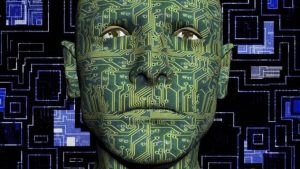
Source : Acadgild
Example
Say you are playing a game along with four of your friends. Your friends are the different layers of the artificial neural network – all standing in a row one behind the other. There is a moderator to enforce the rules of the game. A picture is shown to the first person. His objective is to extract as much information as he can, and pass it on along the row. The game shall go on until the last person can describe the image accurately.While playing, all members standing in queue will have to alter the information, little at a time, to improve the eventual description. Deep learning works in a similar fashion. It refines the information it collects over time to deliver finer results.
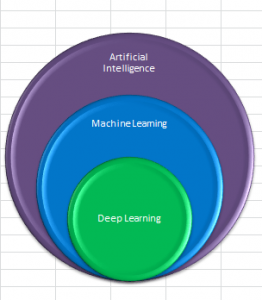
Source : Acadgild
Evolution of AI
The picture above clearly depicts the relationship between artificial intelligence, machine learning, and deep learning. It’s apparent that artificial intelligence is the broadest term. Both machine learning and deep learning are subsets of it. In fact, deep learning is also a subset of machine learning. AI is the broadest term out of the three. It also happens to be the oldest. It originated in the 1950’s when the “Turing Test” became popular. A lot of time and energy was devoted in those days to try and create an algorithm that could mimic human beings. The first real success in this endeavour was achieved when machine learning was introduced in the 70’s.
Machine learning was path-breaking at the time, but it had its limitations. Human curiosity knows no bounds, and the will to create a more robust algorithm persevered. Now, the goal became to overcome the limitations of machine learning.
Fast-forward to 2010 when Google launched its ‘Brain Project’, and the perception of artificial intelligence – of what it meant and could achieve – was changed forever.
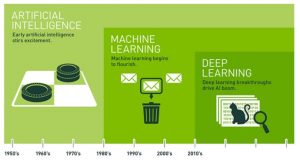
Source : Blogs.nvidia
How Does Data Science Relate to AI, ML & DL?
As mentioned before, data science is an inter-disciplinary field that requires skills and concepts used in disciplines such as statistics, machine learning, visualization, etc. According to Josh wills, a data scientist “is a person who is better at statistics than any software engineer and better at software engineering than any statistician”. He/she is the jack of all trades manipulating and playing with data. How is the data scientist and his field of study related to artificial intelligence, machine learning, and deep learning?
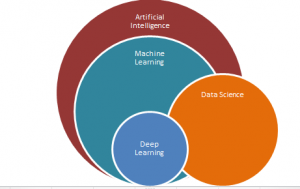
Source : Acadgild
To answer simply, data science is a fairly general term for processes and methods that analyze and manipulate data. It enables artificial intelligence to find meaning and appropriate information from large volumes of data with greater speed and efficiency. Data science makes it possible for us to use data to make key decisions not just in business, but also increasingly in science, technology, and even politics.
Conclusion
Artificial intelligence is a computer program that is capable of being smart. It can mimic human thinking or behavior. Machine learning falls under artificial intelligence. That is to say, all machine learning is artificial intelligence, but not all artificial intelligence is machine learning. For example, a simple scheduling system may be artificial intelligence, but not necessarily a machine that can learn. Then we have deep learning, which is, again, a subset of machine learning. Both – machine learning and deep learning – fall under the broad category of artificial intelligence. Lastly, data science is a very general term for processes that extract knowledge or insights from data in its various forms. Although it has no direct relation to artificial intelligence, machine learning or deep learning, it can be useful to each of the three.
How Artificial Intelligence will shape the Retail Industry
Artificial Intelligence and Machine Learning in the Retail Industry
While the world is busy talking about AI powered technologies such as self-driven cars, machines challenging human intelligence at a game of chess, and AI technologies in recruitment, there is still remains an untapped potential for AI in the retail industry.
With most retailers now focusing towards providing an omni-channel experience for their shoppers, AI can play a crucial role in disrupting the retail industry.
Creating Smart Shops with Artificial Intelligence
While AI assistants such as Siri and Google Home help us maintain our day-to-day groceries list and change our shopping experience, an ideal situation would be to walk into a smart store without any shop attenders or long check-out queues.
Imagine a shopping experience where you can just enter a shop, pick up the stuff you want, and a bunch of facial recognition algorithms process your purchase and automatically deduct money from your digital wallet when you leave the store. Suddenly, shopping seems to become more of technology experience.
Amazon has been marginally successful in replicating this experience for customers with their Amazon Go grocery store. In order for shoppers to use this, they need to install the Amazon Go app. There are digital sensors on the shelves that detect when purchases are made and the money gets deducted from the customer’s account when he or she exits the shop.
Amazing isn’t it? This is what a future ready AI store should ideally look like!
Predicting online customer behavior with Machine Learning
We live in a digital world today where every minute truck loads of data about customer behavior is recorded and stored. But most companies struggle in extrapolating this data into actionable steps that can increase their ROI by 10X times.
You may have luxurious marketing and advertising budgets to target your customers and to get awesome click-through rates, but how are you making your customers tip over the fence and make a sale?
With Machine Learning tools, you can create an intelligent and automated marketing system that helps you with:
- 1) customer segmentation
- 2) predicting customer value and
- 3) designing product recommendations.
But it doesn’t end with just that. Machine learning also helps us optimize our Ad budgets and invest them in the right customers.
In a world where resources and time are always limited, we are forced to make quick and smart decisions. But machine learning algorithms are programmed to analyse this huge pool of customer data within a fraction of seconds and identify customers who are 65% more likely to make a purchase. Thus, in this way ML helps to justify and set optimum ad bids to target customers.
Product recommendation is another favorite pick by top marketers. ML helps to analyse customer behaviour online in depth – the products they are interested in, the blogs they read, the price ranges they operate at etc. Based on all these interactions, a business can invest in curating content that makes the shopping experience as “personal” as possible.
Artificial Intelligence and Cognitive Computing in the Retail industry:
AI and cognitive computing are adding the “innovation” bit to the retail industry. Creating an omni channel experience for customers has become the top most priority for retail brands.
Out of the many retail sections, in this blog post we are going to concentrate mainly on two AI integrated retail categories:
1) Product Recommendations:
IBM’s Watson powered with its cognitive computing abilities is an excellent choice for brands who are looking to provide both in-store and online product recommendations.
1) AI powered retail store
In this example, we see how a New York based wine company called Wine4Me decided to choose the AI technology of IBM Watson to make in-store wine recommendations for its customers. The goal was to make wine shopping an easy and personalized experience.
But the first step was to provide Watson with ample data from wine tasters and in fact teach Watson how people ask and shop for wine. Based on the occasion, price, sweetness, brand and age of the wine, Watson should be able to bring up a list of wine recommendations that would suit the customer’s demand.
Now, this whole AI powered shopping technology works as a win-win for both the retailer and the customer. Customers on one hand enjoy a hassle free and engaging shopping experience while retailers can make better inventory decisions by tracking customer preferences.
2) AI powered digital store
In this example, we will talk about how the San-Francisco based premium brand The North Face integrated Watson on its digital platform to create an unparalleled shopping experience for its customers. The North Face is a premium outdoor product company specializing in outerwear, coats, backpacks etc
Though SEO filters and keyword phrases helps in attracting customers to the website, most brands forget to communicate with their customers and help them find what they want. This is where AI can help you establish that user connect.
Let us assume that a user wants to buy a jacket online, then the AI platform asks the user a series of questions such as purpose of the jacket, the time period during which he will use it, which place will be visiting, color preferences, material preferences and so on. The user is free to answer all these questions in his own style and type in any response.
With every response, the AI will trigger a series of product recommendations that closely match the user’s requirement. Now this sounds fancy doesn’t it?
But it all boils down to data and also literally teaching the AI what could be the possible use case scenarios that users would identify themselves with. Even the most non-obvious statements and taken for granted business scenarios need to be keyed in so that the AI helps to generate the right response.
This next-generation online shopping experience is sure to make both customers and retailers conscious about their expectations. Thus, if used in the right way, AI has great potential to provide product recommendations that can increase revenue from sales by 10x.
2) In-store Sales:
AI is all set to change the traditional shopping experience when a customer walks into the store. With e-commerce booming, you find lesser customers who are willing to enter a store and interact with a store assistant.
So, how can AI help in increasing the customer foot-fall at a brick and mortar retail store? The answer is simple – by using AI powered robots.
Pepper, a humanoid robot from Softbank’s robotics company has been in the news for enriching the customer shopping experiences at retail store and serving as a retail concierge. Stores across the US who have adopted Pepper as the smart shop assistant have recorded almost 70% increase in customer walk-ins and sales. Now that’s huge isn’t is?
But what does this humanoid Pepper do differently from a sales man?
Firstly, Pepper acts as a brand ambassador for the store that drives in customers. Based on sheer curiosity, customers are more likely to stop by your store to experience an interaction with a robot who could help them with their shopping decisions. It almost feels like having a friendly celebrity with whom you can take a tour of the store.
Secondly, the humanoid robot is programmed to sense movement, emotion, offer shopping advice and product information, and answers to questions etc. Thus it helps the user in making an informed purchase. It has a tablet positioned on its chest where the user can key in his preferences and based on that Pepper offers suggestions.
This definitely boosts user engagement and conversations inside a store. And the best part is that Pepper is always connected to the internet and all the data thus collected is stored on the cloud. So, next time when the same customer enters the shop, it becomes easy to showcase products based on his/her interests.
Thus, Pepper helps to automate all the obvious and mundane tasks at a retail store and transform in-store shopping into an engaging and joyful experience for customers.
The future of Artificial Intelligence in Retail
While we are positive and hopeful that the future of retail is likely to be dictated by AI, we also notice that there is still time until this technology gets widely accepted in stores around the world.
One of the major constraints involves high budgets, thus making it easy only for the bigger players such as Amazon, Walmart, Target etc to become early adopters of such technologies.
But having said that, it is time that retailers identify the potential that AI and Machine Learning can make to their business and take steps to make the shift soon.
Artificial Intelligence (AI)
AI (pronounced AYE-EYE) or artificial intelligence is the simulation of human intelligence processes by machines, especially computer systems. These processes include learning (the acquisition of information and rules for using the information), reasoning (using the rules to reach approximate or definite conclusions), and self-correction. Particular applications of AI include expert systems, speech recognition and machine vision.
Machine Learning
Machine learning is a type of artificial intelligence (AI) that provides computers with the ability to learn without being explicitly programmed. Machine learning focuses on the development of computer programs that can change when exposed to new data.
Big Data
Democratizing Big Data with Visual Analytics
Turbo-charge your business analytics and address your routine to complex Big Data challenges with the truim info analytics platform. Trium info is the only platform that empowers business users with an intuitive, easy-to-use interface to leverage the full spectrum of big data analytics technology, without requiring any data science or IT expertise.
The Trium info interface remains consistent whether you are analyzing a small dataset or performing advanced analytics on a multi-terabyte big data cluster with complex data from sensor, social, Point-of-Sale (PoS), and geo-location sources. Users of any skill level navigate rich, insightful dashboards and analytical workflows simply by interacting with visualizations that represent aggregations of billions of data points.
Big Data Connectivity for High Performance Analytics
Trium info offers three primary types of native integration with Hadoop and other big data sources:
- Visualizing Data: Native out-of-the-box data connectors that facilitate super fast interactive data visualizations.
- Performing Calculations:
- Bring the engine to the data: Integration with in-datasource distributed computing frameworks that enable data calculations of any complexity on big data.
- Bring the data to the engine: Integration with external statistical engines that get data directly from any data source, including traditional databases.
Together, these modes of integration offer a combination of visual data discovery and advanced analytics. They enable business users to access, combine, and analyze data from any underlying data structures with dashboards and workflows that are powerful and easy to use.
Big Data Connectors
Trium info Big Data connectors support in-datasource, in-memory and on-demand data access modes. As a result of this data access flexibility, fast interactive visualizations are made possible such that data calculations occur within the data stores and the data is moved into client memory if and when it is needed. Trium info native data connectors include:
- Certified Hadoop data connectors for Apache Hive, Apache Spark SQL, Cloudera Hive, Cloudera Impala, Databricks Cloud, Hortonworks, MapR Drill and Pivotal HAWQ
- Other certified big data connectors include Teradata, Teradata Aster and Netezza
- Connectors for OSI PI historical and real-time sensor data sources
In addition to convenient point-click SQL operations running distributed within the datasource, advanced statistical and machine learning algorithms can be initiated from Trium info to be run in-datasource on very large datasets, only returning the results needed for visualizations in Trium info:
- Users interact with point-and-click dashboards that call scripts using the TERR instance embedded in Spotfir
- The TERR scripts initiate distributed computing jobs via Map/Reduce, H2O, SparkR, or Fuzzy Logix.
- These jobs drive high-performance engines deployed on the Hadoop or other datasource nodes.
- TERR can be deployed as the advanced analytics engine in Hadoop nodes that are driven by MapReduce or Spark. It can also be called on Teradata nodes.
Putting it all together
Combining all these powerful functionalities means that very sophisticated and robust analytic use cases can be encapsulated in easy-to-use interactive workflows
- Certified Hadoop data connectors for Apache Hive, Apache Spark SQL, Cloudera Hive, Cloudera Impala, Databricks Cloud, Hortonworks, MapR Drill and Pivotal HAWQ
- Other certified big data connectors include Teradata, Teradata Aster and Netezza
- Connectors for OSI PI historical and real-time sensor data sources
Analytical Breadth for Big Data
Let’s face it, in today’s interconnected world you are faced with complex problems and difficult decisions. Trium info offers powerful capabilities that empower you to transform vast amounts of diverse data into meaningful insights and make the best possible decisions, fast.
- Advanced and Predictive Analytics
- Content Analytics
- Location Analytics
- Machine Learning
Real-time Event Analytics
Insights from visual analytics and modeling in Trium info can be deployed, at the press of a button, to event processing systems and scored/run on real-time streaming data. This allows you to monitor real-time data and alert end users, such as marketers or engineers, when an anomaly occurs or a new trend begin to emerge. The alerts can combine recent event data with historical data, providing context to enable users to investigate an event’s importance and quickly decide on any necessary intervention.
Trium info Streambase is integrated with Trium info for such real-time streaming analytics. Streambase does real-time math on streaming data; using rules and models published in Trium info. Streambase applies the Trium info insights to streaming data in an automated manner, pushing notifications to a wide array of channels including text, email, database, and BPM systems
Key Features
- Scalable data visualizations
- Intuitive user interface
- Flexible data architecture
- Agile Platform
Python
Python is an interpreted, object-oriented, high-level programming language with dynamic semantics. Its high-level built in data structures, combined with dynamic typing and dynamic binding, make it very attractive for Rapid Application Development, as well as for use as a scripting or glue language to connect existing components together. Python’s simple, easy to learn syntax emphasizes readability and therefore reduces the cost of program maintenance. Python supports modules and packages, which encourages program modularity and code reuse. The Python interpreter and the extensive standard library are available in source or binary form without charge for all major platforms, and can be freely distributed.
Often, programmers fall in love with Python because of the increased productivity it provides. Since there is no compilation step, the edit-test-debug cycle is incredibly fast. Debugging Python programs is easy: a bug or bad input will never cause a segmentation fault. Instead, when the interpreter discovers an error, it raises an exception. When the program doesn’t catch the exception, the interpreter prints a stack trace. A source level debugger allows inspection of local and global variables, evaluation of arbitrary expressions, setting breakpoints, stepping through the code a line at a time, and so on. The debugger is written in Python itself, testifying to Python’s introspective power. On the other hand, often the quickest way to debug a program is to add a few print statements to the source: the fast edit-test-debug cycle makes this simple approach very effective.

